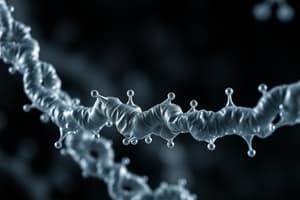Podcast
Questions and Answers
What are the primary elements that make up biomolecules?
What are the primary elements that make up biomolecules?
- Carbon, hydrogen, oxygen, nitrogen, phosphorus, and sulfur (correct)
- Carbon, nitrogen, calcium, and oxygen
- Carbon, hydrogen, and potassium
- Hydrogen, oxygen, and chlorine
Which of the following is NOT a function of carbohydrates?
Which of the following is NOT a function of carbohydrates?
- Energy storage
- Structural components
- Catalyzing biochemical reactions (correct)
- Serve as cell signaling molecules
What structure level does a protein achieve when it consists of multiple polypeptide chains?
What structure level does a protein achieve when it consists of multiple polypeptide chains?
- Primary
- Quaternary (correct)
- Secondary
- Tertiary
Which biomolecule is primarily involved in genetic information transfer?
Which biomolecule is primarily involved in genetic information transfer?
What is one of the roles of lipids in biological systems?
What is one of the roles of lipids in biological systems?
Which type of biomolecule includes enzymes that catalyze biochemical reactions?
Which type of biomolecule includes enzymes that catalyze biochemical reactions?
What are the basic building blocks of nucleic acids?
What are the basic building blocks of nucleic acids?
Which of the following is a characteristic function of proteins?
Which of the following is a characteristic function of proteins?
Flashcards are hidden until you start studying
Study Notes
Biomolecules
1. Definition
- Biomolecules are organic molecules that are essential for life.
- They are mainly composed of carbon, hydrogen, oxygen, nitrogen, phosphorus, and sulfur.
2. Types of Biomolecules
-
Carbohydrates
- Composed of carbon, hydrogen, and oxygen (C, H, O).
- Functions:
- Energy storage (e.g., starch, glycogen).
- Structural components (e.g., cellulose in plants, chitin in fungi).
- Monosaccharides (simple sugars) → Disaccharides → Polysaccharides.
-
Proteins
- Made of amino acids linked by peptide bonds.
- Functions:
- Catalysts (enzymes).
- Structural support (collagen).
- Transport (hemoglobin).
- Defense (antibodies).
- Structure levels:
- Primary (amino acid sequence).
- Secondary (alpha helices and beta sheets).
- Tertiary (3D folding).
- Quaternary (multiple polypeptides).
-
Lipids
- Hydrophobic molecules, primarily made of hydrocarbons.
- Functions:
- Energy storage (triglycerides).
- Membrane structure (phospholipids).
- Signaling molecules (steroids).
- Includes fats, oils, waxes, and phospholipids.
-
Nucleic Acids
- Composed of nucleotides (sugar, phosphate group, nitrogenous base).
- Types:
- DNA (deoxyribonucleic acid): stores genetic information.
- RNA (ribonucleic acid): involved in protein synthesis.
- Functions:
- Genetic information transfer.
- Protein encoding.
3. Importance of Biomolecules
- Serve as the building blocks of cells and tissues.
- Play critical roles in metabolism, energy transfer, and information storage.
- Essential for growth, development, and reproduction of organisms.
4. Interactions and Relationships
- Biomolecules interact through various biochemical pathways.
- Enzymes (proteins) facilitate reactions involving substrates (often other biomolecules).
- Metabolic pathways integrate the functions of carbohydrates, lipids, proteins, and nucleic acids.
5. Applications
- Biotechnology (e.g., genetic engineering using nucleic acids).
- Medicine (e.g., drug design targeting specific proteins).
- Nutrition (understanding dietary sources of biomolecules).
Definition of Biomolecules
- Organic molecules critical for life functions.
- Composed primarily of elements: carbon, hydrogen, oxygen, nitrogen, phosphorus, and sulfur.
Types of Biomolecules
-
Carbohydrates
- Composed of carbon, hydrogen, and oxygen (C, H, O).
- Serve multiple functions:
- Energy storage: starch in plants, glycogen in animals.
- Structural roles: cellulose in plant cell walls, chitin in fungal structures.
- categorized into monosaccharides (simple sugars), disaccharides, and polysaccharides.
-
Proteins
- Formed from amino acids linked by peptide bonds.
- Diverse functions include:
- Catalyzing biochemical reactions (enzymes).
- Providing structural support (collagen in connective tissues).
- Transporting substances (hemoglobin in blood).
- Acting in defense (antibodies in immune response).
- Structure levels include:
- Primary: linear sequence of amino acids.
- Secondary: local folding patterns such as alpha helices and beta sheets.
- Tertiary: overall three-dimensional shape.
- Quaternary: assembly of multiple polypeptide chains.
-
Lipids
- Hydrophobic molecules mainly composed of hydrocarbons.
- Functions include:
- Energy storage, particularly as triglycerides.
- Forming cellular membranes via phospholipids.
- Acting as signaling molecules (steroids).
- Categories include fats, oils, waxes, and phospholipids.
-
Nucleic Acids
- Composed of nucleotides, which consist of a sugar, phosphate group, and nitrogenous base.
- Two primary types:
- DNA (deoxyribonucleic acid): serves as the genetic blueprint, storing genetic information.
- RNA (ribonucleic acid): plays a crucial role in protein synthesis processes.
- Functions encompass genetic information transfer and protein encoding.
Importance of Biomolecules
- Fundamental building blocks of all living cells and tissues.
- Essential roles in metabolism, energy transfers, and storage of genetic information.
- Critical for organism growth, development, and reproduction.
Interactions and Relationships
- Biomolecules engage in complex biochemical networks.
- Enzymes, which are proteins, facilitate substrate reactions involving other biomolecules.
- Metabolic pathways interconnect the functionalities of carbohydrates, lipids, proteins, and nucleic acids.
Applications
- Biotechnology uses biomolecules for genetic engineering and cloning.
- Medicine employs biomolecular research for drug design and therapies targeting specific proteins.
- Nutrition focuses on the dietary implications of biomolecules in health and wellness.
Studying That Suits You
Use AI to generate personalized quizzes and flashcards to suit your learning preferences.




